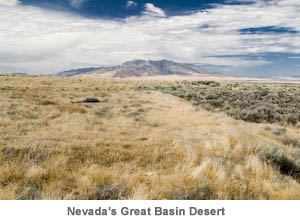Greg Nyquist |
Touring America's Northwest: Nevada
Editor's Note: This article is third in a series of travel sketches from America's northwest, including northern California, Nevada, Idaho, Wyoming, Montana, Washington, and Oregon. You can read the previous article in the series, on northeastern California, by going here.
For most people heading east out of central or northern California, Reno becomes the inevitable portal through which they must pass. Not a bad city, as cities go, is Reno; not particularly a great city, either: more of a middling metropolis, to tell the truth about it. As Nevada's second largest city, Reno enjoys some distinction as a casino-orientated tourist trap. Between Second and Sixth streets in the downtown area there are ten casinos featuring some 4,000 rooms. For the yokels of northern California, Oregon, Idaho, and northern Nevada, Reno makes sense as the place to go to gamble away one's earnings. What other compelling reason could possibly exist to come to Reno, unless as a stopover on the way to someplace else, I couldn't say.
As a place to live, Reno has little to recommend itself. There are, to be sure, people who, due to extreme misfortune, must live in Reno because it is the only place they can find work. Still others may wish to live in Reno to be close to loved ones. But other than those two instances, I cannot think of a single legitimate reason for living in so uninspiring a place. Certainly, no one would want to live in Reno for the weather. Despite its reputation for "mild" conditions, Reno is, more often than not, beastly hot in the summer, brutally cold in the summer, and ferociously windy in the spring. The average low in January is 16° — comparable to the average lows in Cleveland, Chicago and Detroit, three of the nastier weather hell-holes in the United States. In April and May, the infamous Washoe Zephers whistle through the city at speeds reaching one-hundred miles per hour. In the summer, thunderstorms spawn the occasional flash flood.
What can be said of Reno in terms of weather can be said of the rest of the Great Basin Desert. This is high desert country with a vengeance, and no sensible person would voluntarily want to live anywhere within it, unless they happen to be incurable weather masochists. Nevada is primarily a desert state. It is nearly all desert, and a good part of it is high desert. The low desert part of the state is in the southern tip around Las Vegas. Still plenty of miserable weather in this lower part, too, especially for those of us who despise heat. But the winters aren't as cold and brutal in the Las Vegas area as they are in the rest of the state.
Interstate 80, as it leaves the east side of Reno, follows the Truckee River. This is an almost picturesque section of the highway. On a Sunday morning, I saw a couple of photographers who had pulled off to the side of the road. They looked like they were trying to photograph wildlife, but they just as well could have been taking pictures of the river canyon, with the scenic sandstone desert cliffs mirrored in the gently flowing Truckee River.
Although I would hardly describe it as spectacular, the Great Basin Desert is not without its aesthetic charms. Riddled with hills, bluffs, and ridges of various sizes, it at least keeps the eye diverted, and, when the light is just right — say, at sunset or sunrise — it verges toward the spectacular. A simple, modest beauty is afforded by these vast desert plains and mountains — so modest at times that it is hardly noticeable under the pressure of a sweltering summer sun.
A simple, modest beauty is afforded by these vast desert plains and mountains — so modest at times that it is hardly noticeable under the pressure of a sweltering summer sun.
Interstate 80 weaves a curious path through this desert. I say curious because one wonders why it must weave at all. Isn't the shortest distance between two points a straight line? Then why doesn't Interstate 80 take the traveller straight to Salt Lake City in Utah, instead of moving northeast for 140 miles, then going southeast for another 60 miles, then again turning slightly northeast, then once more, after passing through Wells, assuming a southeasterly route, until it at last straightens out at the border and courses in a much more direct fashion through northern Utah. If Interstate 80 went straight to the border from Reno, instead of making its way, like some disorientated animal, close to one hundred miles could be saved. So why the zig-zagging route? I suppose the original designers of the road wanted it to run through the major towns of northern Nevada. So the road must swing way to the north to hit Winnemuca, then swing southward to hit Battle Mountain, and northward again to pass through Elko and Wells. If this is the real reason for Interstate 80's circuitous trespass through Nevada's Great Basin Desert, it is not a very compelling reason. All the towns listed above are hardly important enough to warrant a visit from an interstate. No one in his right mind would ever want to go to any of them, even if just passing through on a freeway. Indeed, for travelers making their way across Nevada to get to someplace better — and nearly any place outside Neveda is better than any place in Nevada — the quicker they make their way through the state, the happier they are likely to be.
There is, to be entirely fair, one section along Interstate 80 that is worth visiting. I have in mind the section that passes the Ruby Mountains, perhaps the most resplendent range in all of Nevada. Highway 227 out of Elko takes you to Lamoille Canyon, the so-called "Yosemite of Nevada," where glacial ice has covered a long, narrow but scenic mountain valley, framed by imposing granite walls. Lamoille Canyon really ought to be turned into a national park. For now, it must be content with being a "national scenic byway" — whatever that means!
For those traveling from California to the Grand Tetons, Wells is where you make the inevitable left to head northward along Highway 93. Not much of a town, as far as the eye can see, is this little hamlet of Wells. Allegedly, there are as many as 1,500 people living here, but where they are domiciled I could not readily determine. The most distinctive landmark in the town is the Flying J gas station. Back in the eighties, one of the great inventions of consumer capitalism was the gasoline station mini mart, where the weary traveler could buy overpriced soft drinks and junk food. In Nevada, they have come up with an even more impressive innovation along these lines: namely, the gas station casino, where travelers can gamble away their remaining excess cash while filling up.
As is well known, casinos are the very lifeblood of Nevada. They account for 40% of the state General Fund revenues and nearly 25% of the jobs in Nevada. They are primary reason most people bother to visit the state. Given the intrinsic irrationality and even idiocy of gambling, these are sobering facts. Why are so many Americans so eager to hand over their hard-earned cash to casino owners and bureaucracies of the state of Nevada? Can't they think of anything better to do with their money? H. L. Mencken once noted that no one ever lost any money from underestimating the great masses of plain people in America. Las Vegas testifies to the truth of this assertion. Fools must ever be separated from their money, and sheep sheared of their wool.
That the thirst for gambling, for throwing away one's money on the odd chance of bagging some unearned gains, must be very strong among the American public is evinced by the curious phenomenon of the Nevada border town. On many of the roads leading out of Nevada one finds a little town dedicated almost solely to gambling. On Highway 93, for example, one finds the appropriately named town of Jackpot, a flourishing little berg that exists almost exclusively for the purpose of separating Idaho's congenital idiots from their money. Driving through Jackpot on a Sunday afternoon, I found parking lots jammed with cars and buses. I hadn't seen so many foolish people concentrated in one place since Reno.
To read the next article in this series, about Idaho, go here.
Greg Nyquist is the webmaster for jrnyquist.com. He can be reached at machiavel@mac.com.




